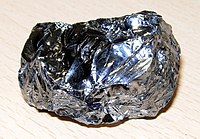
Photo from wikipedia
Large quantities of semiconductor minerals on soil surfaces have a sensitive photoelectric response. These semiconductor minerals generate photo-electrons and photo-hole pairs that can stimulate soil oxidation–reduction reactions when exposed to… Click to show full abstract
Large quantities of semiconductor minerals on soil surfaces have a sensitive photoelectric response. These semiconductor minerals generate photo-electrons and photo-hole pairs that can stimulate soil oxidation–reduction reactions when exposed to sunlight. We speculated that the photocatalysis of semiconductor minerals would affect soil carbon cycles. As the main component of the carbon cycle, soil respiration from paddy soil is often ignored. Five rice cropping areas in China were chosen for soil sampling. Semiconductor minerals were measured, and three main semiconductor minerals including hematile, rutile, and manganosite were identified in the paddy soils. The identified semiconductor minerals consisted of iron, manganese, and titanium oxides. Content of Fe2O3, TiO2, and MnO in the sampled soil was between 4.21–14%, 0.91–2.72%, and 0.02–0.22%, respectively. Most abundant semiconductor mineral was found in the DBDJ rice cropping area in Jilin province, with the highest content of Fe2O3 of 14%. Soils from the five main rice cropping areas were also identified as having strong photoelectric response characteristics. The highest photoelectric response was found in the DBDJ rice cropping area in Jilin province with a maximum photocurrent density of 0.48 μA/cm2. Soil respiration was monitored under both dark and light (3,000 lux light density) conditions. Soil respiration rates in the five regions were (from highest to lowest): DBDJ > XNDJ > XBDJ > HZSJ > HNSJ. Soil respiration was positively correlated with semiconductor mineral content, and soil respiration was higher under the light treatment than the dark treatment in every rice cropping area. This result suggested that soil respiration was stimulated by semiconductor mineral photocatalysis. This analysis provided indirect evidence of the effect semiconductor mineral photocatalysis has on the carbon cycle within paddy soils, while exploring carbon conversion mechanisms that could provide a new perspective on the soil carbon cycle.
Journal Title: Frontiers in Plant Science
Year Published: 2022
Link to full text (if available)
Share on Social Media: Sign Up to like & get
recommendations!